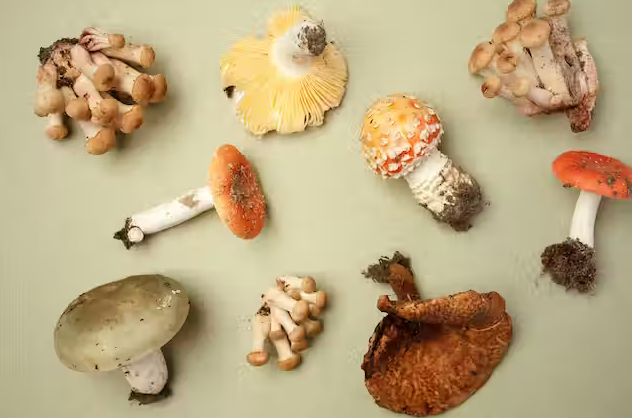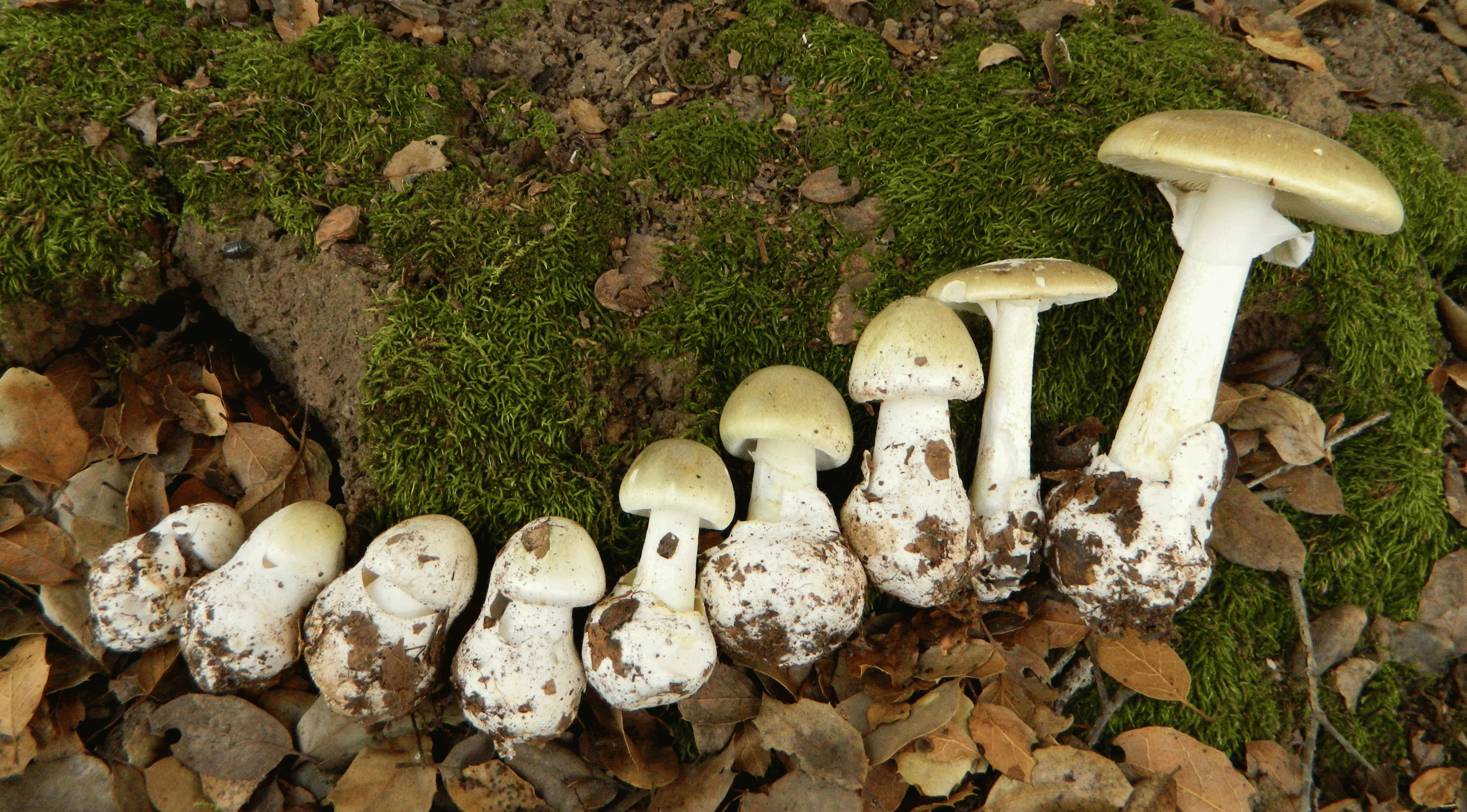Universally appreciated for their culinary, medicinal, and even mystical properties, mushrooms are a diverse group of fungi with thousands of species spreading across our globe. These fascinating organisms spring forth in various shapes, sizes, and colors, enriching our meals with their earthy flavors and intriguing textures. But beneath the umbrella-shaped cap of some, a hidden danger lurks – the sinister potential for deadly poisonings.
Mushrooms, as innocent as they might appear, can harbor a fatal flaw. Among the approximately 10,000 known species, a small but significant number are dangerously toxic. Their toxins are no child’s play, boasting ominous names like amatoxins, orellanine, and phallotoxins, leading to grim outcomes such as liver and kidney damage, hallucinations, or worse, death.

Please read our article How Long Does Food Poisoning Last?
Can You Get Food Poisoning From Mushrooms?
Yes, you can get food poisoning from mushrooms if you eat poisonous or bacterial-contaminated mushrooms. In some cases, food poisoning from mushrooms can be severe and even fatal.
There are two main ways that mushrooms can cause food poisoning:
- Poisonous mushrooms: There are over 100,000 species of mushrooms worldwide, and only a tiny fraction are edible. Some mushrooms contain toxins that can make you sick or even kill you. If you are unsure whether a mushroom is edible, it is best to err on the side of caution and not eat it.
- Bacterial contamination: Mushrooms can also become contaminated with harmful bacteria, such as Salmonella, Listeria, and Staphylococcus. These bacteria can cause food poisoning symptoms such as nausea, vomiting, diarrhea, and abdominal cramps. Mushrooms can become contaminated with bacteria during growth, harvesting, processing, or storage.
The symptoms of food poisoning from mushrooms can vary depending on the type of mushroom and the amount of bacteria ingested. However, the most common symptoms include:
- Nausea
- Vomiting
- Diarrhea
- Abdominal cramps
- Fever
- Headache
- Muscle aches
- Chills
In some cases, food poisoning from mushrooms can be severe and even fatal. If you experience any of these symptoms after eating mushrooms, it is essential to seek medical attention immediately.
There are several things you can do to reduce the risk of food poisoning from mushrooms:
- Only eat mushrooms that a qualified mushroom forager has identified.
- Buy mushrooms from a reputable grocery store or market.
- Store mushrooms properly in the refrigerator.
- Cook mushrooms thoroughly before eating them.
- Avoid eating raw mushrooms.
If you are careful, you can enjoy mushrooms safely. However, it is essential to be aware of the risks of food poisoning and take steps to reduce your risk.
Here are some additional tips for avoiding food poisoning from mushrooms:
- Wash your hands thoroughly before and after handling mushrooms.
- Use clean utensils and cutting boards when preparing mushrooms.
- Do not wash mushrooms before cooking them, as this can spread bacteria.
- Cook mushrooms until they are soft and tender.
- Do not eat mushrooms that have turned brown or slimy.
- Throw away any mushrooms stored for more than a few days.
Poisonous Toxic Mushrooms
While over 10,000 types of mushrooms exist, only about 50-100 are known to be toxic. Some can cause mild symptoms, while others can cause severe illness and even death.

Some of the toxins that can cause food poisoning from mushrooms include:
- Amatoxins: These are found in the Amanita species like the Death Cap (Amanita phalloides) and Destroying Angels (Amanita virosa, Amanita bisporigera). They are highly toxic and can lead to liver and kidney damage.
- Orellanine: Found in the Cortinarius species. It has a long latency period and can cause kidney damage several weeks after ingestion.
- Psilocybin and Psilocin: These are the hallucinogenic components found in Psilocybe mushrooms. While not directly poisonous, they can induce powerful hallucinations and psychological effects that can lead to dangerous behavior.
- Muscarine: Found in Inocybe and Clitocybe species, this toxin primarily affects the nervous system causing salivation, sweating, and blurred vision.
- Gyromitrin/Monomethylhydrazine (MMH): Found in Gyromitra species (False Morels). It can cause nausea, vomiting, severe seizures, and liver damage.
- Coprine: Found in the Inky Cap (Coprinopsis atramentaria). It interferes with the body’s ability to break down alcohol, leading to symptoms similar to disulfiram (used in alcohol aversion therapy) when alcohol is consumed within a few hours to a few days after the mushroom is eaten.
- Ibotenic Acid and Muscimol: Found in the Fly Agaric (Amanita muscaria) and Panther Cap (Amanita pantherina), these toxins can cause hallucinations, drowsiness, and nausea.
- Alpha-amanitin is the main toxin of several lethal Amanita mushrooms and causes severe liver dysfunction and digestive issues.
- Phallotoxins: While less toxic than amatoxins, they are found in similar species and contribute to overall toxicity.
- Ergot alkaloids: While not a mushroom, Claviceps purpurea (a fungus) produces these toxins, which can cause hallucinations and gangrene.
Mushrooms Bacterial contamination
Salmonella, Listeria, and Staphylococcus are the most common bacteria that can contaminate mushrooms. These bacteria can be found in soil, water, and air and contaminate mushrooms during growth, harvesting, processing, or storage.
Salmonella: This bacterium is one of the most common causes of foodborne illness. It can contaminate mushrooms if grown in contaminated soil, handled by someone with Salmonella, or if they come into contact with contaminated water or surfaces. Symptoms of Salmonella poisoning can include nausea, vomiting, abdominal cramps, diarrhea, fever, and headache.
Listeria monocytogenes: This bacterium can survive and grow under refrigeration temperatures, making it particularly difficult to control. Contaminated mushrooms can lead to listeriosis, a severe infection that can cause fever, muscle aches, and diarrhea. In severe cases, the infection can spread to the nervous system, causing headaches, stiff neck, confusion, and even death. Listeriosis is particularly dangerous for pregnant women, as it can lead to miscarriage or life-threatening newborn infection.
Staphylococcus aureus: This bacterium is often carried by humans and can be transferred to mushrooms through improper handling or if the mushrooms come into contact with contaminated surfaces. The toxin produced by this bacterium can survive cooking. It can cause staphylococcal food poisoning, with symptoms including rapid onset of nausea, vomiting, abdominal cramping, headache, and changes in blood pressure and pulse rate.
Bacterial contamination can occur at any stage, from the field to the point of sale. Therefore, the cultivation, harvesting, processing, transportation, and storage of mushrooms should all be done under conditions that minimize the risk of contamination. This includes practicing good hygiene, keeping tools and surfaces clean, and storing mushrooms at the appropriate temperature.
In addition, consumers can help prevent bacterial food poisoning by handling and storing mushrooms correctly at home. This includes washing hands before and after handling mushrooms, storing them in the refrigerator, cooking them thoroughly, and consuming them within a few days of purchase.
What are the signs of bacterial contamination in mushrooms?
Mushrooms contaminated with bacteria may appear slimy, discolored, or foul. They may also be soft and mushy.
Mushrooms can be contaminated with bacteria just like any other food item, and there are several signs you might observe that indicate bacterial contamination:
- Odor: Fresh mushrooms should have a mild, earthy smell. If the mushrooms smell sour, yeasty, or like ammonia, it’s a sign they are spoiling and could be contaminated with bacteria.
- Color: Fresh mushrooms should have a bright, consistent color. It could indicate bacterial growth if they darken or develop dark spots. Also, sliminess is an indicator of decay.
- Texture: Fresh mushrooms should feel firm to the touch. If they are slimy or mushy, it could be a sign of bacterial contamination.
- Mold: Visible mold on mushrooms is an obvious sign of contamination and spoilage. Mold may appear as fuzzy spots of varying colors like white, blue, green, or black.
- Packaging: If the packaging is swollen or there is a lot of liquid at the bottom of the container, it might be a sign that the mushrooms are spoiling and could be contaminated with bacteria.
How can you prevent bacterial contamination of mushrooms?
There are several things you can do to prevent bacterial contamination of mushrooms:
- Choose mushrooms from a reputable source.
- Wash your hands thoroughly before and after handling mushrooms.
- Use clean utensils and cutting boards when preparing mushrooms
- Cook mushrooms thoroughly before eating them.
- Do not eat mushrooms that have turned brown or slimy
- Throw away any mushrooms stored for more than a few days.
What should you do if you think you have eaten contaminated mushrooms?
If you think you have eaten contaminated mushrooms, it is essential to seek medical attention immediately. Symptoms of food poisoning from mushrooms can start within a few hours of eating the contaminated mushrooms and can last for several days.
Here are some additional tips for preventing bacterial contamination of mushrooms:
- Store mushrooms in the refrigerator at 40°F or below.
- Do not wash mushrooms before cooking them.
- If you are growing mushrooms at home, take steps to prevent contamination, such as using sterile growing materials and equipment.
Conclusion
Their inherent charm is laced with a delicate paradox; some mushrooms can simultaneously offer a delicious ingredient for our dishes and, in unfortunate circumstances, become agents of deadly poisonings.
Risks can present themselves in various forms, from deadly toxins found in wild species to bacterial contamination in commercially grown mushrooms. However, it’s crucial to remember that most mushrooms are safe and that poisoning is rare. That being said, precaution is essential. Only consume wild mushrooms when sure of their identification and consider the risks of bacterial contamination when storing and handling all types of mushrooms.
Education and awareness can play a monumental role in reducing the incidence of mushroom poisoning. Whether you’re a forager, a home cook, or simply a lover of mushrooms, knowledge of potential hazards empowers you to make informed decisions and enjoy mushrooms safely.
Therefore, treat every encounter with these remarkable organisms as an opportunity for exploration and learning. Even as we savor their rich, earthy flavors and marvel at their myriad forms, let’s maintain a healthy respect for their potent potential. After all, the world of mushrooms, much like the more fantastic natural world, is a blend of the delightful and the dangerous – a testament to the incredible complexity of life on Earth.
- Does Eating Spicy Chips Burn Calories? - November 10, 2023
- How Do They Make Spicy Chips in Factories? - October 27, 2023
- What Foods Cause Kidney Stones? - October 3, 2023
